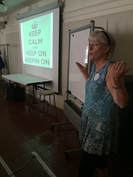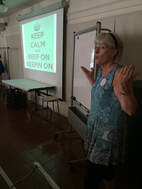
As we walk through our classroom doors on January 2nd, let's reflect on how our writing instruction is going so far this school year. Teaching writing is a lot of work, a complex and layered labor. To really allow our teaching and our students' learning to develop into deep thinking through recursive process, we must instruct across days and weeks. If we decide to consider and commit to this work as a labor of love, we will be giving ourselves and our students the most positive mindset with which to teach and learn.
If you are like me, you will be searching your teacher's soul, asking, "How can I infuse my writing instruction with positivity in such a way that my students catch the 'I can do this!' spirit and set out on writing journeys already believing that they have stories to tell and voices with which to tell them?"
I previously shared my thinking about a positive approach to teaching writing and the immense difference it can make in how your students imagine themselves as writers in a blogpost on 12/10/17. For the next few weeks, I want to elaborate on each of the points that I made then, and give you ideas on how to drive your practice in a positive direction.
Today we will begin with you.
"When your think-alouds expose the struggles and challenges of writing, but you maintain excitement in your voice as you model your own writing process, students will notice and absorb the "I Can Do This" belief that you demonstrate."
When I used the word "absorb" in the statement from my earlier post, I did not choose randomly. Our students are like sponges, soaking up not only the information we present, but also taking in the way we teach it. Our teaching stances are the filters through which students internalize our instruction. We want our own positive attitudes to seep into their understandings of new learning.
How do we keep it positive when sometimes it just seems so dauntingly difficult? Let's begin with your teacher think-alouds. This is, arguably, the part of writing instruction that teachers struggle with the most. But, this is also where you have your students' full attention. Where you can orchestrate a communal writing experience with your students watching as you muscle through the writing process.
Make it as easy on yourself as possible!
1. Backwards plan. Once you have identified the scope and sequence of the lessons you want to teach in a unit, you will know what writing craft moves, strategies, or skills you will need to model in each lesson.
2. Be prepared. Draft an example of the kind of writing your students will be doing based on your backwards planning. As you write, remember to leave opportunities for revision throughout the unit based on the lessons you are going to teach.
3. Share the load. If you are fortunate enough to work with a team that plans units of study together, you can all share a common teacher story. I once modeled a lesson using the same personal narrative story for teachers in five different fifth grade classrooms. The students in each room heard the story as my own and never blinked an eye! Any team can do it!
4. Keep your writing on the same level as your students'. Your ideas, organization, word choice, mechanics, etc. should be accessible to your writers. This makes your writing a much easier undertaking. Don't make it harder on yourself than necessary!
5. Believe. As you post your words for the class, whether written ahead of time or scribed in front of your students, believe that what you are doing is powerful. You are building students' capacity to be purposeful writers as they watch and hear you think through the decisions you make as a writer. A kind of "If she can do it, I can do it!" mentality. Say it outright to your students! Make it your battle cry..."If I can do it, you can do it!" You will be amazed by the sheer power of leading by example as you see your students begin to believe right along with you.
Next time I will share ideas about a second point made in the 12/10/17 blogpost.
"When your differentiated instruction continually makes a bee-line for what's great in their writing, students will be encouraged to keep working, to keep reaching for precise language, organized structures, fully developed ideas, etc."
In the meantime, as we all try to stay warm this week, let's welcome our students back with a renewed commitment to modeling our thinking as we make decisions in our own writing. And let's do so with a positive attitude that will inspire our writers to believe in themselves as they see us write courageously in front of them. We are all in this together.
Have a great writing week!
#allkidscanwrite

 RSS Feed
RSS Feed
